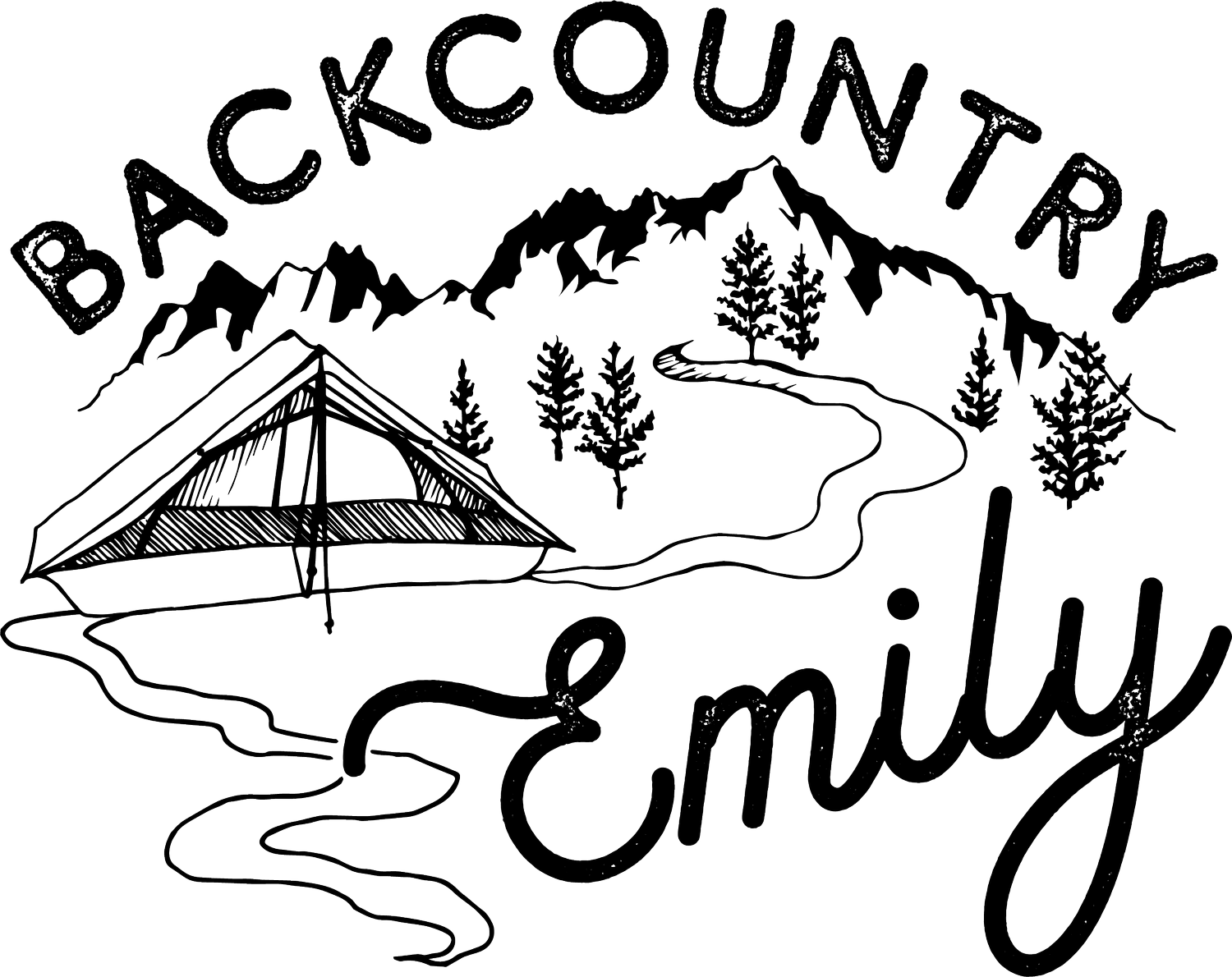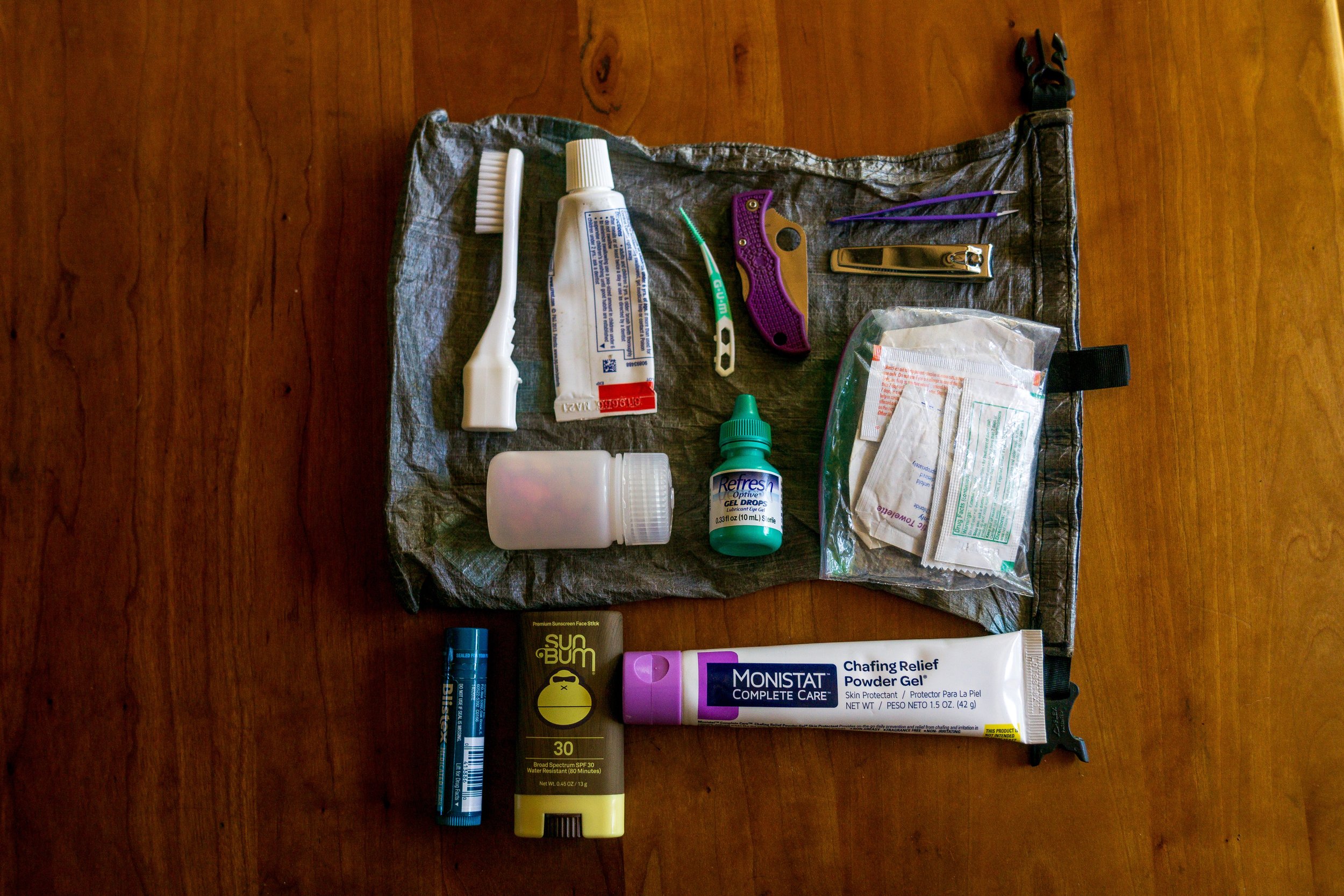Gear Dive: What's In My (sorta-UL) Ditty Bag
What’s a “ditty bag” you may ask? Essentially, a ditty bag is something that carries all those little things when you’re backpacking. The stuff that could easily get lost in your pack, so you keep it all together! My ditty bag is basically a combination of my toiletry kit, first aid kit, and repair kit. Not every single item is actually kept in the bag: some are lashed to the outside of my pack, and technically, my potty kit is in a separate bag. But, we’re going to talk about those things here too because they’re related.
Keep reading to find out what I pack, and why I pack it!
Note: this post contains affiliate links and I may earn a small commission if you choose to purchase an item (at no additional cost to you). Thank you for your support if you do choose to use these links.
First Aid Kit & Toiletries
A first aid kit (FAK) is an important thing to keep stocked in your hiking gear. It is a part of the 10 Essentials, after all! I kind of mesh my FAK and toiletries together because some items truly do serve dual purposes, and some of the toiletry items are actually preventative first aid, especially if we’re talking about long backpacking trips.
I want to mention something important about first aid kits. As tempting as it is, it’s impossible to carry everything and the kitchen sink in your hiking first aid kit. Your kit is also only as good as how knowledgeable you and your partners are. So, I do not carry a huge first aid kit, even when I am solo hiking. I carry the items that I know I could use to help mitigate a situation, and hopefully tide me over long enough to be able to self-evacuate or wait for help after hitting the SOS button on the PLB. I know from my Wilderness First Aid course that there is only so much that can be done in a wilderness setting. The end goal is to evacuate to front-country medical care in 99% of incidents.
FIRST AID
Drugs (~4 days worth of the following): Ibuprofen @ 800mg per dose, Benadryl @ 1/day, Immodium @ 1/day, 2 Aspirin, my personal rx meds. These are held in a small pill bottle.
2-3 Alcohol swabs.
2-4 squares of gauze.
Triple antibiotic ointment.
Burn relief gel.
2 regular bandaids.
Leukotape wrapped around pill bottle.
Leukotape is like moleskin, but 100% better, and not padded. The adhesive is super strong and it lays flat against the skin. It is great for using on hot spots before they turn into blisters, and for using as bandage adhesive with gauze. It is good in conjunction with moleskin to keep the moleskin in place as moleskin adhesive is kind of bad.
This is amazing at preventing and healing chafe.
Great for pulling a splinter out and preventing infection from that, or stingers if you’re stung by a bee.
Hand Sanitizer.
This is dangling off the back of my pack near my pee rag. Easy access is key!
The more practical usage of my bandana is using it as a snot rag. But in an emergency, it can be used as a tourniquet.
Garmin inReach Mini with an active subscription.
The inReach is a last resort at calling for help after self-evacuation has failed.
Toiletries
Some of these items you really only need to bring when on backpacking trips (like the toothbrush and body wipes).
At least SPF 30, include an SPF lip balm.
I have slight dry eye, but eyedrops are also good first aid in case you get something in your eye. You can use it to flush it out. You can buy eyedrops in packs with single-use vials to avoid over-packing.
I prefer Picaridin because if DEET leaks, it can literally ruin your gear (I’ve seen hipbelt pockets with holes from leaked DEET). I only bring bug spray when hiking under heavy bug pressure. This is preventative first aid as well - Mosquitos can carry West Nile Virus in North America, and Picaridin fends off ticks as well, which can carry Lyme Disease and Rocky Mountain Spotted Fever.
This can definitely be considered a luxury item, but I prefer body wipes to bringing soap just because its so much easier to clean yourself with the wipes than scrubbing with soap 200ft away from water. Keeping your body clean helps with chafe and other rashes from forming in the creases of your body.
Toothbrush & Toothpaste
Make it travel-sized for ultimate weight savings.
Floss
Can also be used for gear repair as a replacement for thread! Make sure you choose an unwaxed version if you want it to do double duty.
I only bring these on thru-hikes to make sure I’m keeping my toenails short. I want to keep my own to avoid finding some in a hiker box and potentially getting a toe fungus or something from someone else.
Repair Kit
My repair kit is suuuper tiny! The items in here will help with small repairs, but with the type of trips I do, it usually covers all of my bases.
I always carry Tenacious tape, which works well with silnylon tents, and clothing hole repairs. I also carry DCF (Dyneema composite fiber) tape when I’m carrying a DCF tent.
Inflatable sleeping pad repair kit
Crucial for inflatable sleeping pads! Mine is the one made by Therm-a-rest and includes an alcohol swab to clean the area, a gooey patch, and then a piece of pre-cut tenacious tape to stick over the gooey patch that goes on the hole itself. I’ve had to patch an inflatable pad a couple of times in the field, and it’s really not hard!
Needle
Can be used with floss to repair tent mesh, clothing, etc., and as a means to pop large blisters in conjunction with sterilizing it with a flame and prepping the blister area with alcohol and antibiotic ointment to avoid infections.
Safety Pin
Can be used in a pinch in lots of scenarios! Mainly with fabrics.
Duct Tape
I carry duct tape wrapped around my trekking pole. Heavy-duty duct tape can be used for repair in many situations, but I actually hesitate to use it on gear that I might want to send in for repair or for a warranty, just because the residue left behind is hard to get off and could make a long-term repair more difficult.
The knife is useful for cutting repair tape, along with having many other uses in my kit!
I’m mentioning the bandana again as a potential fix for a chewed-through backpack arm strap: you could tie the two ends of the bandana to the new two ends of the chewed-through strap. It will definitely take some Macguyver-ing, but its better than shouldering a pack on one shoulder for the rest of a hike!
Okay, so all of the above items weigh a little less than a pound combined, and all go into a DCF roll-top dry bag (except for the inReach, bandana and hand sanitizer, which are hanging on the outside of my pack).
Potty Kit
Again, this is a pretty bare-bones toilet kit! You don’t need much to go to the bathroom successfully in the woods. The only time when mine is a little more complex and heavy is when I carry a Wag Bag in certain high alpine or desert environments.
I carry the Deuce of Spades brand since it’s super ultralight!
Toilet paper
I try to budget for ~6 squares per day. I generally try to do the first 1-2 wipes with natural material like wide, soft leaves or smooth stones.
2 Ziplocks
One ziplock carries the clean TP & the second ziplock bag. The second ziplock bag carries the used TP.
The best pee rag out there! This also hangs on the outside of my pack to air out.
Hand sanitizer & body wipes are also a part of this kit. I only pull a body wipe out if it’s… particularly messy. ;)




